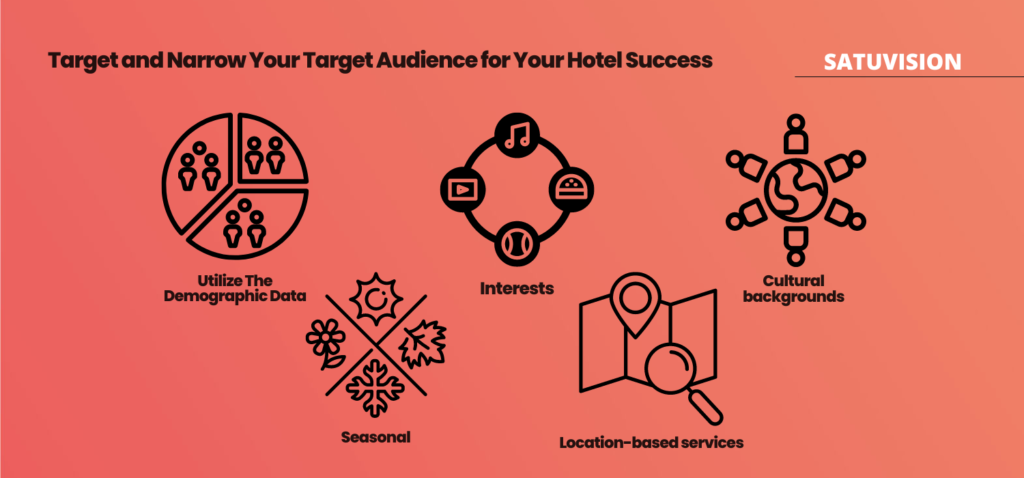Targeting and Narrowing Your Audience
Understanding your hotel’s target audience is one of the most effective ways to grow your hotel business. If you want to increase your hotel prospects and encourage people to stay, you must delve into and understand how to narrow your target audience.
But first, you must be aware of the type of guests who want to stay at your hotel.
Targeting and narrowing your audience will lead your create better marketing plans, and by the end boosts business growth. In this blog, we will explore how a hotel’s location affects the types of guests it attracts.
Table of Contents
Target and Narrow Your Target Audience for Your Hotel Success
Explore how to narrow your target audience and learn how your hotels can attract certain types of guests. This will assist you to focus your marketing efforts and campaigns, so here are several ways to narrow your target audience:

Tailoring Your Audience by Cultural Background
Demographic data refers to details that describe a population, including factors like age, gender, income, education level, and geographic location. This data serves as a valuable tool for hotels to target the audience. It also knows the unique requirements and preferences of various demographic segments.
You can utilize demographic data to target a hotel’s audience. Here are the following strategies you should try to utilize the demographic data to narrow your target audience:
- Define Your Target Audience: Get the insight into your ideal guests, understanding their values, preferences, and booking habits. Several methods exist to collect this data, such as surveys, reviews, social media, competitor analysis, and market segmentation.
- Create Comprehensive Profiles: Create detailed profiles of your target audience, encompassing demographics, preferences, motivations, pain points, and booking behaviors. This will enable tailored marketing strategies aligned with your guest’s needs and expectations.
- Improving The Use of Social Media Platforms: Share compelling content on platforms frequented by your target audience, such as Facebook, Instagram, Twitter, or YouTube. Foster user-generated content, reviews, and interactions while engaging with followers and potential guests.
- Establish a Blog or Newsletter: Deliver pertinent information, tips, and insights through a blog or newsletter, showcasing your destination and local attractions to attract potential guests.
- Collaborate with Influencers and Local Businesses: Partner with influencers matching your audience’s profile and interests, offering them complimentary stays or experiences in exchange for authentic reviews or promotions. Forge alliances with local businesses that provide complementary services and create cross-promotional campaigns or packages.
- Implement Geo-targeting: Refine your audience based on location, targeting individuals interested in local experiences or planning staycations within a specified radius.
- Highlight Hotel Amenities: Focus on attracting individuals who would benefit from your hotel’s unique amenities such as exceptional dining, specialty beverages, or spa services.
- Utilize Sales and Marketing CRM Software: Integrate CRM systems to track and analyze the sales process, facilitate targeted offers, and assess the return on investment.
Free Resource: 10 Templates to Mastered Hotel Email Marketing
Narrowing Your Target Audience by Interests
To narrow a hotel’s target audience based on interests, you can begin by identifying nearby attractions. You can also find popular destinations that are interesting to guests and convenient to your hotel.
Other than that, focus on your hotel’s unique amenities, such as renowned restaurants, rooftop bars, or luxurious spas, which align with potential guests’ interests and preferences.
You can also utilize geo-targeting to narrow down your audience based on location, targeting peoples that are interested in local experiences or planning stays within specified areas.
If your hotel is located in Bali, you can also show off by relaxing on the white sands of Kuta Beach. You can also explore the ancient temples of Uluwatu and Tanah Lot and experience the vibrant underwater world by snorkeling or diving in the crystal-clear waters of Karangasem.
Tailoring Your Audience by Cultural Background
You can create a specific offer to target specific cultural backgrounds. This is one way to effectively narrow down your target audience. By understanding different cultural groups’ unique preferences, traditions, and values, you can tailor your guest amenities, services, and marketing strategies to better resonate with these audiences.
Whether offering culturally inspired cuisine, providing language-specific services, or hosting events and celebrations catering to specific cultural traditions, your hotels can create a more inclusive and welcoming environment for guests from diverse backgrounds.
For example, if your hotel aims to attract Chinese tourists, you can highlight how close your hotel is to important cultural places like temples and historical sites that Chinese people appreciate.
Seasonal Segmentation
Whether we like it or not, seasonal fluctuations and cultural events greatly influence the tourism market. Weather conditions and special events attract particular groups of people from around the world to Bali. This leads to unavoidable peak and low seasons.
For example, Bali’s warm and tropical climate, with relatively consistent temperatures throughout the year, attracts tourists seeking sunshine and relaxation during the summer. Additionally, events such as the Bali Arts Festival, Nyepi (Balinese New Year), and Galungan Festival, which celebrate Balinese culture and traditions, are significant draws for visitors.
By recognizing the significance of these events, your hotels can strategically plan your marketing campaigns and promotions to appeal to guests during these peak times, enhancing your overall guest experience and maximizing occupancy rates.
Target Audience by Location-based Services
You can use location-based services to create a precise hotel target audience. Narrowing a target audience by providing location-based services involves offering personalized recommendations to guests based on location.
This could include suggesting nearby restaurants, tourist attractions, or transportation options tailored to their preferences and needs. By maximizing technology like GPS or mobile apps, hotels can enhance the guest experience by offering convenient and relevant suggestions that help guests make the most of their stay.
For instance, if your hotel is close to a beach, you can say that the hotel faces the beach and it’s just a short walk. If your hotel is near the airport and easy to reach, this method makes guests happier and helps build customer loyalty and satisfaction.
Read also: Hotelier Guide: How To Market A New Hotel [2024]
Conclusion
Understanding and targeting your hotel’s audience is important for your business growth. By tailoring marketing strategies to meet guests’ needs and preferences, you can enhance their experience. Utilize demographic data, and focus on interests, cultural backgrounds, or seasonal trends to effectively narrow your target audience. Highlight your hotel’s unique amenities and proximity to local attractions to maximize appeal. For example, in Bali, showcases nearby beaches, temples, and cultural festivals. Leverage location-based services to provide personalized recommendations, adding value to guests’ stays and fostering loyalty.
Frequently Asked Questions
The location of your business can impact your customers’ behavior, preferences, and needs in numerous ways. For instance, it can shape your market’s climate, culture, language, income levels, legal regulations, and competitive landscape.
Location-based marketing enables organizations to reach consumers at a detailed, individual level by delivering online or offline messages tailored to their physical location. By leveraging location data, marketing teams can target consumers based on their proximity to a store, local events, and other relevant qualifiers.





